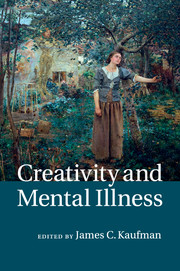Book contents
- Frontmatter
- Dedication
- Contents
- List of figures
- List of tables
- List of contributors
- Preface
- Acknowledgments
- Part I Creativity and mental illness: the state of the field
- 1 A socio-historical overview of the creativity–pathology connection: from antiquity to contemporary times1
- 2 The mad (creative) genius: what do we know after a century of historiometric research?
- 3 Reviewing recent empirical findings on creativity and mental illness
- 4 Building connections on sand: the cautionary chapter
- Part II Cognitive and neuroscientific perspectives on creativity and mental illness
- Part III Creativity and the spectrum of mental illness
- Part IV Creativity and mental illness: possible commonalities
- Part V Creativity and mental health
- Part VI Creativity and mental illness: what now?
- Index
- References
2 - The mad (creative) genius: what do we know after a century of historiometric research?
from Part I - Creativity and mental illness: the state of the field
Published online by Cambridge University Press: 05 August 2014
- Frontmatter
- Dedication
- Contents
- List of figures
- List of tables
- List of contributors
- Preface
- Acknowledgments
- Part I Creativity and mental illness: the state of the field
- 1 A socio-historical overview of the creativity–pathology connection: from antiquity to contemporary times1
- 2 The mad (creative) genius: what do we know after a century of historiometric research?
- 3 Reviewing recent empirical findings on creativity and mental illness
- 4 Building connections on sand: the cautionary chapter
- Part II Cognitive and neuroscientific perspectives on creativity and mental illness
- Part III Creativity and the spectrum of mental illness
- Part IV Creativity and mental illness: possible commonalities
- Part V Creativity and mental health
- Part VI Creativity and mental illness: what now?
- Index
- References
Summary
On November 19, 1909, Frederick A. Woods, a geneticist at the Massachusetts Institute of Technology (MIT), coined a “new name for a new science.” This he called historiometry, which covers when “the facts of history of a personal nature have been subjected to statistical analysis by some more or less objective method” (p. 703). Woods (1911) later identified historiometry not just as a science but an “exact science” and claimed that the technique was particularly well suited for the scientific “psychology of genius.” In the original article, Woods (1909) also listed a dozen examples of historiometric inquiries that appeared before the method had acquired a formal name. The list included Francis Galton’s (1869) Hereditary genius, Alphonse de Candolle’s (1873) Histoire des sciences et des savants depuis deux siècles, James McKeen Cattell’s (1903) “A statistical study of eminent men,” and Havelock Ellis’ (1904) A study of British genius. Although Wood intended his list to be comprehensive, he actually overlooked the first bona fide historiometric study published by Adolphe Quételet (1835/1968) more than a third of a century before Galton’s (1869) book (cf. Galton, 1865). Of course, Woods’ (1909) bibliography could not possibly encompass examples of historiometric research published in the century or so since the method acquired a name. Even so, among the most notable examples are Lewis M. Terman (1917), Catharine Cox (1926), Edward L. Thorndike (1950), and R. B. Cattell (1963). It is noteworthy that many historiometricians are themselves noteworthy, and some could themselves count as genuine geniuses – but I will not name names.
If historiometry is truly useful in the scientific study of genius, then it must be able to address some of the central questions in the psychology of genius (Simonton, 2009a). Is genius born or made? Is genius generic or domain specific? Is genius isolated or necessarily situated in a sociocultural context? Is genius mad? Because this chapter is part of a volume devoted to creativity and mental illness, it is the last question that I address here. What do historiometric investigations tell us about the relation between genius and madness – and especially the relation between creative genius and madness? But before I can review the main empirical results dealing with this question, I first must give a brief overview of the methods involved.
- Type
- Chapter
- Information
- Creativity and Mental Illness , pp. 25 - 41Publisher: Cambridge University PressPrint publication year: 2014
References
- 12
- Cited by



